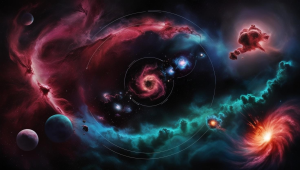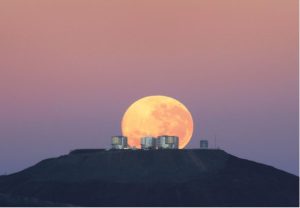
WORMHOLES:COSMIC SHORTCUTS
What if you could rocket from Earth, not to the Moon or Mars, but down a wormhole that loops all the way across the vast Milky Way, slashing travel time
Artificial Intelligence (AI) has become one of the attending tools in contemporary space science. With an increasing number of space agencies and the appearance of private players approaching the universe, artificial intelligence changes navigation, analysis of measurements, and control and management of spacecraft. This article examines how AI is being implemented in space missions and goes further to analyze the future prospect of Artificial Intelligence in space research.
A very important function that has to be accurately performed during space missions is navigation. Space vehicles are required to cover large space and for a long time , with very little interference from man. Artificial Intelligence algorithms, especially the ones using machine learning concepts, have improved the degree of accuracy of trajectory planning and optimization. In contrast to conventional forms of working, the focus here was on pre-codified patterns of behavior, while in the AI system, decisions are made based on certain conditions and circumstances.
For instance, the Mars rovers that are managed by NASA’s Jet Propulsion Laboratory, use AI to self-navigate. These rovers are required to drive through the Martian surface that is filled with hazards and uncertainties. Machine learning makes it possible for the rovers to detect slipperiness, obstacles, and choose the best path and even adapt to new changes on the ground within the rover’s small time frame of operation.
In interplanetary missions, AI helps in mapping out routes that require the smallest amount of fuel and time. Existing missions are used to collect large datasets which are later processed by the machine learning algorithms to predict the trajectory. This capability is especially useful in long-distance target missions like Jupiter’s moon Europa or Saturn’s moon Titan where real-time human interaction is impossible.
Quantitative and qualitative analyses as well as discovery science
Missions performed in space yield voluminous information, information that may at times overwhelm the human experts on board. AI is central in collecting and processing such data to make valuable information out of raw data.
Satellite imagery is one example; Metadata such as tags is another; The world of satellites and other physical objects traveling around the Earth and other space objects provides a big amount of visual data. Such images can then be processed using algorithms such as AI neural networks and can easily isolate/examine certain features within the images. This comprises perceiving the weather, assessing changes in the environment, and in some instances, even in the search for alien life forms.
AI is also used in evaluating information received from space telescopes. The JWST, which is expected to be the successor of the Hubble Space Telescope, will produce Gigabytes, if not Terabytes of data. There is a lot of information coming from astronomy: space images, data on exoplanets’ orbits, and mass; AI is needed to help to find new planets, to research their atmosphere in search of traces of life. Automation enables researchers to provide initial analysis of time-stamped data in a short amount of time, possibly preventing oversight of certain irregularities or patterns by personnel.
Inexperienced personnel are not in a position to make significant decisions, this makes it important for long duration space missions to be operated autonomously. Vehicles exploring planets or other celestial bodies or playing through space have to work autonomously for a long duration mostly because signals from Space take a huge amount of time to reach Earth. Through the incorporation of AI, the tasks performed by these spacecraft are complex and can be carried out independently.
The Rosetta mission of the European Space Agency, where it landed a probe on a comet planned and operated using AI for its navigation. It refers to the high-speed decisions that the spacecraft had to take instrumentally that include adjustments of spacecraft path and use of the scientific instruments. In its mission, Rosetta incorporated AI algorithms that helped it perform as planned while dealing with specific unforeseen conditions.
The future belongs to AI with the possibility to explore space for people. When people move away from the Moon to Mars and even other planets, robotic assistants that are supported by AI will be required. These robots can help in doing insignificant repair and maintenance work, do scientific research experiments and even during rescue operations, cutting down the stress and hard work on astronauts.
AI has undiscovered potential for the future of space exploration. Robots could be controlled by artificial intelligence and this could lead to discoveries of the Martian surface and other substance bearing celestial bodies. Self-driving vehicles could be dispatched to the extremities of the solar system and past it to wander through the outer reaches of space and obtain never-before-seen data.
SETI or the search for extra-terrestrial intelligence is another area where AI aligns well and could be helpful. Artificial intelligence can look for the specific patterns in space signals that may be a sign of other intelligent beings. This capability could dramatically transform how we comprehend the universe as well as our position in it.
Nevertheless, the application of AI also has some limitations, especially in space exploration. AI reliability and robustness, in this case, are crucial since failures in space are not an option. One major engineering challenge remains hence bespoke AI that can work in the cold, warring, inconsistent environment of space must be designed.
However, ethical issues should not be ignored. Of course, further issues need to be discussed. With AI now making more decisions, who is responsible and how can we know When decisions are being made on behalf of people, questions of responsibility and accountability come to the fore. It is important that AI works according to the principles acceptable in the society, or in other words, aligned with human values.
In space, AI is helping with navigation, improving data analysis and automation of parts of space missions. Its manifestation of computing in terms of big data analysis and decision making within seconds, is fuelling research activities and explorations to far off and harsh terrains. There is still much to be done and likely faces more problems, but space exploration through the use of artificial intelligence is the key to future discoveries about space.

What if you could rocket from Earth, not to the Moon or Mars, but down a wormhole that loops all the way across the vast Milky Way, slashing travel time

If you go outdoors on a clear evening and also search for it, you might have the ability to see Jupiter beaming brilliantly amongst the celebrities. At the exact same

Stars, the dazzling points of light that fill up the evening skies are the foundation of galaxies plus the cradles of life itself. From their birth in large clouds of

In the mission to recognize deep space mankind has actually developed progressively effective devices to observe deep space. Completion of this venture is the Extremely Large Telescope (ELT) which is

Space debris, also known as space junk, refers to the defunct artificial objects orbiting Earth. These objects include decommissioned satellites, spent rocket stages, and fragments from collisions and explosions.

The search for exoplanets– planets that orbit stars outside our planetary system– has actually quickly developed into one of the most interesting and dynamic fields of astronomy
Write to
Jasmine Gogoi at csr@scientifictemperament.com
Let’s develop our society with a scientific heart. Join us to build the scientifically nurtured future →
One Response
wow, great to kow